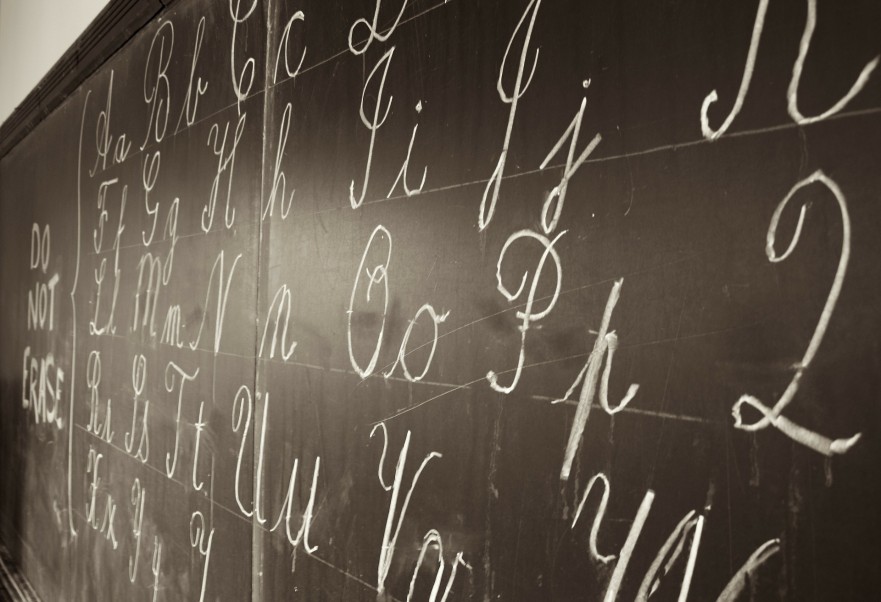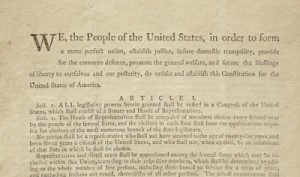Does cursive handwriting have a place in today’s schools? That depends on who you talk to, but I say yes, it does.
You may be thinking, “Typing skills are needed in the real world.” Yes, of course, but one skill shouldn’t come at the exclusion of another. I teach my fifth graders cursive (if they don’t know it already) because I have seen how it can influence their writing and effort. I also teach typing skills because my students need that skill to work on our webpage, type the writing portion of the AZ Merit test, and more.
Dr. Virginia Berninger, a researcher at the University of Washington, has shown that print handwriting, cursive handwriting, and typing on a keyboard are associated with different brain patterns. She reported that cursive writing in particular improves the interaction between the left and right cerebral hemispheres of the brain that involve thinking, language, and working memory.
Dr. Beringer’s research found what I’ve watched in my classroom the past few years – that when children wrote with a pen and paper, they had more ideas, wrote more words and wrote them faster than when typing.
Dr. Beringer indicates that she sees an advantage for learning handwriting through sixth grade. Interestingly brain imaging indicates that when older students are asked to come up with ideas for writing projects or essays, the better handwriting they have, the more neural activity seen in the brain image.
Multiple studies found that students who take notes by typing on a laptop rather than writing don’t perform as well on tests on the same material. Researchers believe that students who take notes on a laptop transcribe lectures word for word, while students who hand-write notes process information and reframe it in their own words, reinforcing and deepening the learning and moving it to long term memory.
The College Board even found that students who wrote in cursive on the SAT essay portion of the test tended to score slightly higher, perhaps because they could write faster than their printing counterparts and focus more on the content of the essay.
Other research suggests that cursive may be an effective tool against dyslexia and conditions associated with fine motor skill difficulties. Others list reasons to learn cursive such as better spelling, grammar, and increased legibility.
Anecdotally, I find that all students benefit from learning cursive because it is a multi-sensory repeated experience where they must integrate fine motor skills with visual and tactile processing. Though I teach cursive to all my students, I find that students with learning difficulties and ADD/ADHD or students who are “early finishers” (aka rushers) benefit the most. Learning cursive is something any student can accomplish. I witness a boost in self-confidence from some of the kids in my class who may not often be acknowledged for superior academic skills in school but can boast about their lovely cursive handwriting. For many students it is a fun time to express creativity and work on personalization.
Some adults feel so strongly about this issue that it has been brought to 11 state legislatures over the past few years, this year including Arizona. Arizona’s version of the bill — SB 1197 — would require public schools include cursive instruction in the minimum course of study, which defines what subjects schools need to teach students like reading, math, and science. Senators were concerned about students’ ability to read historical documents like the Constitution or to sign legal documents. Let’s address the argument about reading historic documents. As lofty as that goal may sound, handwriting of long ago only vaguely resembles today’s cursive handwriting, so that issue is pretty moot. Most of us, even cursive readers and writers, would most likely find a printed copy if we were going to teach it for comprehension and ideas anyway.
Benefits of learning and writing cursive should capture the attention of local school associations, not be forced upon us as another unfunded mandate from our legislature. Putting cursive instruction into statute limits local control of how and when it will be taught.
The Arizona Standards Development Committee, made of professional, practicing teacher leaders, has been discussing and considering adding cursive to the appropriate grade levels. This issue should go through the review process by professional educators, under the supervision of the Arizona Department of Education, and with the ultimate approval of the State Board of Education, not legislated by politicians in the capital. This idea sets a dangerous precedent of allowing the legislature to mandate anything they want teachers to teach.
As I tell my students, your handwriting shows that you care. As much as I love the speech-to-text feature, I also love to receive a handwritten note from my students, complete with their “John Hancock.” If you care about this issue (maybe not cursive, but professional educators deciding what should be taught), then please take the time to let your legislator hear from you.











Comments 5
It’s almost as if you were sitting in my grade level meeting yesterday! We were just having this conversation, granted we don’t teach cursive, but the discussion was centered around whether or a not a handwriting “program” was necessary. If so what type, D’Nealian, Manuscript, etc. Thanks for sharing your knowledge & expertise!
As it happens, my preference as a handwriting teacher (actually a former “handwriting washout” turned handwriting teacher) are the Italic programs. How did those come off, in your grade level meeting discussion?
If you are not familiar with this category of programs, here are some links:
http://graphics8.nytimes.com/images/2009/09/08/opinion/OPED-WRITING.1.pdf, , http://www.BFHhandwriting.com, http://www.handwritingsuccess.com, http://www.briem.net, http://www.HandwritingThatWorks.com, http://www.italic-handwriting.org, http://www.studioarts.net/calligraphy/italic/hwlesson.html, http://www.freehandwriting.net/educational.html
The claims about cursive and SAT scores have been around for a while. To check them out, in 2009 I contacted the “SAT people” to whom the Senator refers — an organization correctly known as the Educational Testing Service/College Board: the designers of the SAT exam. I was quickly put into touch with an ETS/College Board staffer named Katherine Levin — klevin@collegeboard.org — responsible for addressing public questions about the SAT.
Ms. Levin informed me that the measured difference between SAT scores of cursive writers and other writers is extremely small. Specifically, it is 1/5 of a point — on an exam worth several thousand points.
In fact, that tiny difference between scores of cursive writers versus scores other writers is _so_ tiny that it is even smaller than the score difference between male students and female students taking the SAT, and is likewise smaller than the score difference between students who do (or don’t) happen to use the word “I” or “me” in their SAT essays. (The supporters of cursive, as far as anyone knows, have yet to claim that educate would improve if students stopped being female or using the word “I.”)
Something similar happened a little later, when I heard about the research of Dr. Virginia Berninger (not “Beringer,” which is how your article misspells it in two out of three occurrences) and contacted her. She very plainly stated that her research has been misquoted to make it appear to favor cursive (for brain organization and so on) above any of the other forms of handwriting. (Although I am no longer in contact with her, others who are also following the research on this issue tell me that the various misrepresentation of her work on this issue continue to be repeated in the popular press: apparently because their are people who want the stories to be true.)
Regardless, I agree that handwriting matters. Handwriting matters immensely — but does cursive matter? The research is surprising. For instance, it has been documented that legible cursive writing averages no faster than printed handwriting of equal or greater legibility. (Sources for all research are listed below.)
More recently, it has also been documented that cursive does NOT objectively improve the reading, spelling, or language of students who have dyslexia/dysgraphia.
This is what I’d expect from my own experience, by the way. As a handwriting teacher and remediator, I see numerous children, teens, and adults — dyslexic and otherwise — for whom cursive poses even more difficulties than print-writing. (Contrary to myth, reversals in cursive are common — a frequent cursive reversal in my caseload, among dyslexics and others, is “J/f.”)
— According to comparative studies of handwriting speed and legibility in different forms of writing, the fastest, clearest handwriters avoid cursive — although they are not absolute print-writers either. The highest speed and highest legibility in handwriting are attained by those who join only some letters, not all: joining only the most easily joined letter-combinations, leaving the rest unjoined, and using print-like shapes for letters whose printed and cursive shapes disagree.
Reading cursive still matters — but reading cursive is much easier and quicker to master than writing the same way too.
Reading cursive, simply reading it, can be taught in just 30 to 60 minutes — even to five- or six-year-olds (including those with dyslexia) once they read ordinary print.
There’s even a free iPad app teaching how: called “Read Cursive” — appstore.com/readcursive
Given the importance of reading cursive, why not teach this vital skill quickly — for free — instead of leaving it to depend upon the difficult and time-consuming process of learning to write in cursive (which will cost millions to mandate)?
We don’t require our children to learn to make their own pencils (or build their own printing presses) before we teach them how to read and write. Why require them to write cursive before we teach them how to read it? Why not simply teach children to read cursive — along with teaching other vital skills, such as a form of handwriting that is actually typical of effective handwriters?
Just as each and every child deserves to be able to read all kinds of everyday handwriting (including cursive), each and every one of our children — dyslexic or not — deserves to learn the most effective and powerful strategies for high-speed high-legibility handwriting performance.
Teaching material for practical handwriting abounds — especially in the UK and Europe, where such handwriting is taught at least as often as the accident-prone cursive which is venerated by too many North American educators. Some examples, in several cases with student work also shown: http://www.BFHhandwriting.com, http://www.handwritingsuccess.com, http://graphics8.nytimes.com/images/2009/09/08/opinion/OPED-WRITING.1.pdf, http://www.briem.net, http://www.HandwritingThatWorks.com, http://www.italic-handwriting.org, http://www.studioarts.net/calligraphy/italic/hwlesson.html, http://www.freehandwriting.net/educational.html )
Even in the USA and Canada, educated adults increasingly quit cursive. In 2012, handwriting teachers across North America were surveyed at a conference hosted by Zaner-Bloser, a publisher of cursive textbooks. Only 37% wrote in cursive; another 8% printed. The majority — 55% — wrote with some elements resembling print-writing, others resembling cursive.
(If you would like to take part in another, ongoing poll of handwriting forms — not hosted by a publisher, and not restricted to teachers — visit http://www.poll.fm/4zac4 for the One-Question Handwriting Survey, created by this author. As with the Zaner-Bloser teacher survey, so far the results show very few purely cursive handwriters — and even fewer purely printed writers. Most handwriting in the real world — 75% of the response totals, so far — consists of print-like letters with occasional joins.)
When even most handwriting teachers do not themselves use cursive, why glorify it?
Believe it or not, some of the adults who themselves write in an occasionally joined but otherwise print-like handwriting tell me that they are teachers who still insist that their students must write in cursive, and/or who still teach their students that all adults habitually and normally write in cursive and always will. (Given the facts on our handwriting today, this is a little like teaching kids that our current president is Richard Nixon.)
What, I wonder, are the educational and psychological effects of teaching, or trying to teach, something that the students can probably see for themselves is no longer a fact?
Cursive’s cheerleaders (with whom I’ve had some stormy debates) sometimes allege that cursive has benefits which justify absolutely anything said or done to promote that form of handwriting. The cheerleaders for cursive repeatedly state (sometimes in sworn testimony before school boards and state legislatures) that cursive cures dyslexia or prevents it, that it makes you pleasant and graceful and intelligent, that it adds brain cells, that it instills proper etiquette and patriotism, or that it confers numerous other blessings which are no more prevalent among cursive users than among the rest of the human race. Some claim research support — citing studies that invariably prove to have been misquoted or otherwise misrepresented by the claimant.
So far, whenever a devotee of cursive claims the support of research, one or more of the following things has become evident as soon as others examined the claimed support:
/1/ either the claim provides no source (and no source is provided on request)
or, almost as often,
/2/ when sources are cited and can be checked (by finding and reading the cited document), the sources provided turn out to include and/or to reference materials which are misquoted or incorrectly represented by the person(s) offering these as support for cursive,
or, even more often,
/3/ the claimant correctly quotes/cites a source which itself indulges in either /1/ or /2/.
Cursive devotees’ eagerness to misrepresent research has substantial consequences, as the misrepresentations are commonly made — under oath — in testimony before school districts, state legislatures, and other bodies voting on educational measures. The proposals for cursive are, without exception so far, introduced by legislators or other spokespersons whose misrepresentations (in their own testimony) are later revealed — although investigative reporting of the questionable testimony does not always prevent the bill from passing into law, even when the discoveries include signs of undue influence on the legislators promoting the cursive bill? (Documentation on request: I am willing to be interviewed by anyone who is interested in bringing this serious issue inescapably before the public’s eyes and ears.)
By now, you’re probably wondering: “What about cursive and signatures? Will we still have legally valid signatures if we stop signing our names in cursive?” Brace yourself: in state and federal law, cursive signatures have no special legal validity over any other kind. (Hard to believe? Ask any attorney!)
Questioned document examiners (these are specialists in the identification of signatures, the verification of documents, etc.) inform me that the least forgeable signatures are the plainest. Most cursive signatures are loose scrawls: the rest, if they follow the rules of cursive at all, are fairly complicated: these make a forger’s life easy.
All handwriting, not just cursive, is individual — just as all handwriting involves fine motor skills. That is why any first-grade teacher can immediately identify (from the print-writing on unsigned work) which of 25 or 30 students produced it.
Mandating cursive to preserve handwriting resembles mandating stovepipe hats and crinolines to preserve the art of tailoring.
SOURCES:
Handwriting research on speed and legibility:
/1/ Arthur Dale Jackson. “A Comparison of Speed and Legibility of Manuscript and Cursive Handwriting of Intermediate Grade Pupils.”
Ed. D. Dissertation, University of Arizona, 1970: on-line at http://www.eric.ed.gov/?id=ED056015
/2/ Steve Graham, Virginia Berninger, and Naomi Weintraub. “The Relation between Handwriting Style and Speed and Legibility.” JOURNAL OF EDUCATIONAL RESEARCH, Vol. 91, No. 5 (May – June, 1998), pp. 290-296: on-line at http://www.jstor.org/stable/pdfplus/27542168.pdf
/3/ Steve Graham, Virginia Berninger, Naomi Weintraub, and William Schafer. “Development of Handwriting Speed and Legibility in Grades 1-9.”
JOURNAL OF EDUCATIONAL RESEARCH, Vol. 92, No. 1 (September – October, 1998), pp. 42-52: on-line at http://www.jstor.org/stable/pdfplus/27542188.pdf
Handwriting research on cursive’s lack of observable benefit for students with dyslexia/dysgraphia:
“Does cursive handwriting have an impact on the reading and spelling performance of children with dyslexic dysgraphia: A quasi-experimental study.” Authors: Lorene Ann Nalpon & Noel Kok Hwee Chia — URL: http://www.researchgate.net/publication/234451547_Does_cursive_handwriting_have_an_impact_on_the_reading_and_spelling_performance_of_children_with_dyslexic_dysgraphia_A_quasi-experimental_study
and
http://dyslexia.yale.edu/EDU_keyboarding.html
Zaner-Bloser handwriting survey: Results on-line at http://www.hw21summit.com/media/zb/hw21/files/H2937N_post_event_stats.pdf
Ongoing handwriting poll: http://poll.fm/4zac4
The research most often misrepresented by devotees of cursive (“Neural Correlates of Handwriting” by Dr. Karin Harman-James at Indiana University):
https://www.hw21summit.com/research-harman-james
Background on our handwriting, past and present:
3 videos, by a colleague, show why cursive is NOT a sacrament:
A BRIEF HISTORY OF CURSIVE —
http://youtu.be/3kmJc3BCu5g
TIPS TO FIX HANDWRITING —
http://youtu.be/s_F7FqCe6To
HANDWRITING AND MOTOR MEMORY
(shows how to develop fine motor skills WITHOUT cursive) —
http://youtu.be/Od7PGzEHbu0
Yours for better letters,
Kate Gladstone
DIRECTOR, the World Handwriting Contest
CEO, Handwriting Repair/Handwriting That Works
http://www.HandwritingThatWorks.com
handwritingrepair@gmail.com
I agree whole-heartedly!!!!! My high-school son needed to sign a legal form yesterday, and he *printed* his name! I was shocked and dismayed. Cursive homeschool sessions this summer!!!
What an incredibly interesting post! When I was in school myself, there was never an emphasis on cursive handwriting – I can’t even imagine its prioritization now in light of technology being more commonplace in schools from early grades.
To be honest with you, I still don’t know how to write certain letters in cursive: the only thing I am fully confident in writing in cursive is my name. I have never heard about the SAT score differences between those who wrote in cursive vs. those who did not – how interesting! I’ll definitely read more into that.
The benefits you also outlined in this piece were also relatively unbeknownst to me. Since cursive has never been stressed or made important in my life, I assumed that it was somewhat unimportant in general.
Once again, very interesting! I enjoyed the read.